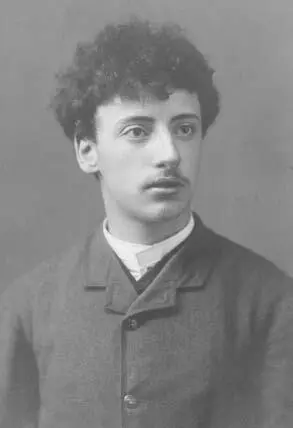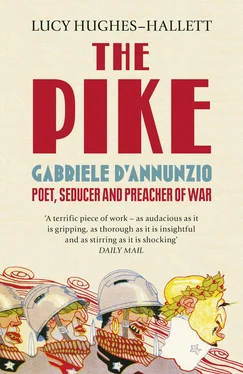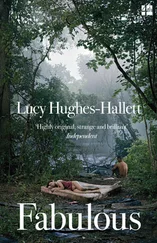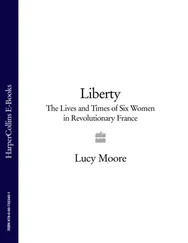Still busily promoting himself and his work, d’Annunzio obtained some kind of introduction to Cesare Fontana, a rich Milanese, a connoisseur of the arts and a prodigal spender of his own considerable fortune. D’Annunzio sent him a ‘psychological sketch’ of himself.
He pulsates, he writes, with ‘the first fires of approaching young manhood’. He has ‘an inordinate desire for knowledge and for glory, which burdens me often with a dark, tormenting melancholy’. He cannot tolerate any ‘yoke’. He despises ‘meanness of spirit’. He is ‘an ardent lover of new Art and lovely women: most unusual in my tastes: most tenacious in my opinions: outspoken to the point of harshness: prodigal to the point of ruin: enthusiastic to the point of madness … What else? Ah! There’s something I forgot: I’m a wicked poet and an intrepid chaser of dreams.’ Apparently so artless, with its disdain for punctuation and exclamation marks, this letter is a deft piece of self-advertisement. In it d’Annunzio fits himself to the model of the romantic hero. He lays claim to sophisticated vices (those beautiful women, those wicked poems). He slips in a gentle reminder of how very young he still is. Several times over the next two years he asked Fontana to put in a word for him with editors in Milan.
Further copies of Primo Vere were sent out. One went to the influential critic Guiseppe Chiarini. In approaching him, d’Annunzio wrote, he felt as bashful as a loutish peasant who, on being introduced to a distinguished person, turns red as a boiled prawn and twists his hat in his hands unable to say a single sensible thing. Having summoned up this image of sweet diffidence, the shameless self-publicist proceeded to make such a good impression on the older man that the two were soon corresponding genially about their shared love of Heine and Horace. D’Annunzio had found himself yet another first-rate master (he addresses subsequent letters to Chiarini: ‘Mio carissimo Signor Professore’) and he had also got himself some invaluable press coverage. In May 1880, Chiarini reviewed Primo Vere in the widely read Roman journal, the Fanfulla della Domenica. He hailed the now just seventeen-year-old d’Annunzio as ‘a new poet’ with an ‘uncommon aptitude’. Within days d’Annunzio had sent him his next volume, along with a letter asking the question that was always on his mind. If he is going to be ‘charming’, ‘pleasing’, and no more, he’ll give up writing straight away. He can’t stand ‘little artists … little poets’. He’d much rather be an engineer, or a lawyer. He’d even rather be a small-town mayor (like his father). So the important question was: ‘Can I cover myself with glory?’
Within a year of his first book’s appearance, d’Annunzio, whose collected works were eventually to run to forty-eight volumes, had brought out two more. In Memoriam, dedicated to his grandmother, who had recently died, was published in May 1880, followed in November by a second edition of Primo Vere with forty-three new poems (throughout his career d’Annunzio was to repeatedly revise, re-package and re-sell his work). In each case Francesco Paolo paid the printer’s bills, but d’Annunzio himself was personally responsible for the books’ design. He was already knowledgeable about book production and literary business. Writing from his school desk to the printer, he fussed over paper quality and font sizes. He argued vigorously over the printer’s terms and negotiated a distribution deal with a local bookseller. As for the books’ promotion, father and son each did their part of the work. To celebrate the appearance of Primo Vere (second edition), Francesco Paolo gave a banquet on the terrace of the Villa Fuoco. Gabriele found a more ingenious way of attracting attention to the work.
Reading the English Romantics, he had reflected on the ways Keats’s and Shelley’s early deaths had left their names enveloped in a glimmering haze of pathos. It was a few days before Primo Vere’s second publication that the editor of the Florentine Gazzetta della Domenica received a postcard from Pescara, from an unknown informant (d’Annunzio himself), advising him that the ‘young poet already noted in the republic of letters’ had died suddenly after falling from his horse. The editor ran the story prominently. The news was picked up by papers all over Italy. In Turin the tragic death of the ‘last-born of the Muses’ was lamented. In Ferrara tribute was paid to the marvellous boy who was ‘the joy of his parents, the love of his friends, the pride of his masters’. The schoolboy poet had ceased to be someone spoken of only in the ‘republic of letters’. He had become a celebrity. He might not yet have achieved glory, but he had attained fame.

LIEBESTOD
A DAY OF TUSCAN SPRING SUNSHINE, a stream running between banks starred with flowers; nearby the cupola of a church glinting, tall cypresses rising above the walls of an ancient villa; in the background blue hills. Along the path comes a dark maiden: black eyes, black hair, black eyebrows, pale, pale face. A young man walks towards her. Days later he writes to tell her that he is hers forever.
It could be a tableau painted by Dante Gabriel Rosetti or Burne-Jones, prints of whose work Gabriele had seen in Nencioni’s rooms. It could be a scene from Tennyson’s Idylls of the King, or from Swinburne’s Laus Veneris (In Praise of Venus). Gabriele had been reading both poets. It was in fact the meeting of two flesh-and-blood teenagers as described by one of them: d’Annunzio, in Florence for the Easter vacation before his last term at school, falling precipitately in love with the seventeen-year-old daughter of his favourite teacher.
It wasn’t his first erotic experience, but it was the first of his romances. In d’Annunzio’s case the ambiguous word is the right one. All of his love affairs were at once real relationships – carnal and ardent – and literary creations. Vivere scrivere was one of his mottoes – ‘To live to write’. Sexual experience especially fuelled his creative energy. Looking back years later on his first kiss, he wrote that it was ‘the very moment when my life began to be my art and my art began to be my life’. In love, he reached for his pen.
The black-eyed girl by the stream was Giselda Zucconi. Dark-haired and heavy-jawed (like Gabriele’s mother, like several more of the women he would love), she was unusually well-educated for a girl, and a competent pianist. Her father, Tito Zucconi, taught modern languages at the Cicognini, and had become yet another of d’Annunzio’s mentors. Zucconi was a dashing figure, a teacher very different from the ‘greasy-handed priests’ about whom d’Annunzio wrote so contemptuously. He had fought alongside Garibaldi: he was himself a poet. He befriended the brilliant student, took him for long walks on days off and invited him to visit his family in Florence.

D’Annunzio, looking back regretfully in middle age, describes himself as he looked then: ‘the brow smooth beneath the dense mass of dark hair. The eyebrows drawn in such a pure line as to give something indefinably virginal to the melancholy of the big eyes. The beautiful half-open mouth.’ Self-regarding as it is, the description matches the photographs. Giselda was entranced. D’Annunzio had begun writing short stories set in the Abruzzi, heavily influenced by Guy de Maupassant and Giovanni Verga. On his second visit to the house he read Giselda one of them, a morbid tale involving a dumb beggar and the frozen corpse of a little girl. When he first encountered Giselda walking by the stream he had felt ‘an I-don’t-know-what’. When he saw her eyelashes wet with tears as she listened to his story he decided it was love.
Читать дальше














